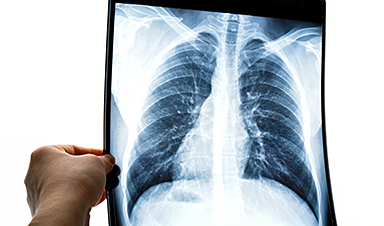Engineers at the University of California San Diego have developed an experimental vaccine that could prevent the spread of metastatic cancers to the lungs. The key ingredients of the vaccine are nanoparticles—fashioned from bacterial viruses—that have been engineered to target a protein known to play a central role in cancer growth and spread.
Metastasis is a process involving the migration of cancer cells from their primary site to other parts of the body. Recent studies have identified S100A9, a protein typically released by immune cells, as a key player in this process. Its normal role is to regulate inflammation. However, an excess of S100A9 can attract cancer cells like a magnet, causing them to form aggressive tumors and facilitating their spread to other organs, such as the lungs.
A team led by Nicole Steinmetz, a professor of nanoengineering at the UC San Diego Jacobs School of Engineering, developed a vaccine candidate that can modulate the levels of S100A9 when it goes haywire. When injected subcutaneously, the vaccine stimulated the immune system in mice to produce antibodies against S100A9, effectively reducing the protein levels and minimizing cancer metastasis to the lungs. The vaccine also increased the expression of immune-stimulating proteins with anti-tumor properties, while decreasing the levels of immune-suppressing proteins.
“S100A9 is known to form what is called a premetastatic niche within the lungs, creating an immunosuppressive environment that allows for tumor seeding and growth,” said study first author Young Hun (Eric) Chung, a UC San Diego bioengineering Ph.D. alumnus from Steinmetz’s lab. “By reducing S100A9 levels, we can effectively counteract the formation of this premetastatic niche, leading to a reduced attraction and increased clearance of cancer cells to the lungs.”
“This is a clever, new approach to vaccination in that we are not targeting tumor cells, but rather the tumor microenvironment so that it prevents the primary tumor from making new tumors,” said Steinmetz, who is the founding director of the UC San Diego Center for Nano-ImmunoEngineering and co-lead of the university’s Materials Research Science and Engineering Center (MRSEC). “We are essentially changing the whole immune system to be more anti-tumor.”
How it works
The vaccine consists of nanoparticles made from a bacterial virus called Q beta. The nanoparticles were grown from E. coli bacteria and isolated. Afterwards, a piece of the S100A9 protein was attached to the surface.
How it works is that the Q beta virus nanoparticles act as bait for the immune system. This virus is harmless to animals and humans, but immune cells recognize it as foreign and get fired up to attack to search for a pathogen. When the immune cells see that the virus nanoparticles display a piece of the S100A9 protein, they produce antibodies to go after that protein.
An advantage of using antibodies, Steinmetz noted, is that they help keep the levels of the target protein in check.
“With this form of immunotherapy, we are not necessarily knocking out all of the protein, but we are reducing the levels everywhere,” said Steinmetz.
Testing the vaccine candidate
The vaccine was tested in metastatic mouse models of melanoma and triple-negative breast cancer, an aggressive and hard-to-treat cancer type. Healthy mice were first administered the vaccine, then challenged with either melanoma or triple-negative breast cancer cells through intravenous injection. Vaccinated mice exhibited a significant reduction in lung tumor growth compared to unvaccinated mice. In unvaccinated mice, the injected cancer cells circulated throughout the body and eventually homed in on the lungs to form metastatic tumors.
The researchers note that this vaccine strategy combats tumor spread, not the primary tumor itself.
“While S100A9 does get overexpressed in certain primary tumors, it is mainly indicated in metastatic disease and progression,” said Chung. “The protein is involved in the formation of immunosuppressive tumor microenvironments. Therefore, we found that our vaccine is much more effective at reducing metastasis, and not in reducing the growth of the primary tumors.”
Another set of experiments demonstrated the vaccine’s potential to offer protection against cancer metastasis after surgical removal of the primary tumor. Mice with triple-negative breast cancer tumors who received the vaccine post-surgery demonstrated an 80% survival rate, while 30% of unvaccinated mice survived after surgery.
“These findings are the most clinically relevant, as they closely model what could happen in real-life scenarios,” said Steinmetz. “For instance, a patient diagnosed with an aggressive cancer who undergoes surgery to remove their tumor may be at risk of recurrence and metastasis to the lungs. We envision that this vaccine could be administered post-surgery to prevent such recurrence and outgrowth of metastatic disease.”
Next steps
Before the vaccine can progress to human trials, more comprehensive safety studies are needed.
“S100A9 is an endogenous protein within the lungs, and there aren’t a lot of data out there that demonstrate what happens when S100A9 is abolished,” said Chung. “We know that S100A9 is important in the clearance of pathogens, and future studies should better test whether reducing S100A9 levels decreases the patient’s ability to fight infections, especially in cancer patients who may have weakened immune systems.”
Future work will also explore the vaccine’s effectiveness when combined with other cancer therapies, with the aim of improving its efficacy against hard-to-treat cancers.
More information: Young Hun Chung et al, Viral nanoparticle vaccines against S100A9 reduce lung tumor seeding and metastasis, Proceedings of the National Academy of Sciences (2023). DOI: 10.1073/pnas.2221859120
Journal information: Proceedings of the National Academy of Sciences
News
Lower doses of immunotherapy for skin cancer give better results, study suggests
According to a new study, lower doses of approved immunotherapy for malignant melanoma can give better results against tumors, while reducing side effects. This is reported by researchers at Karolinska Institutet in the Journal of the National [...]
Researchers highlight five pathways through which microplastics can harm the brain
Microplastics could be fueling neurodegenerative diseases like Alzheimer's and Parkinson's, with a new study highlighting five ways microplastics can trigger inflammation and damage in the brain. More than 57 million people live with dementia, [...]
Tiny Metal Nanodots Obliterate Cancer Cells While Largely Sparing Healthy Tissue
Scientists have developed tiny metal-oxide particles that push cancer cells past their stress limits while sparing healthy tissue. An international team led by RMIT University has developed tiny particles called nanodots, crafted from a metallic compound, [...]
Gold Nanoclusters Could Supercharge Quantum Computers
Researchers found that gold “super atoms” can behave like the atoms in top-tier quantum systems—only far easier to scale. These tiny clusters can be customized at the molecular level, offering a powerful, tunable foundation [...]
A single shot of HPV vaccine may be enough to fight cervical cancer, study finds
WASHINGTON -- A single HPV vaccination appears just as effective as two doses at preventing the viral infection that causes cervical cancer, researchers reported Wednesday. HPV, or human papillomavirus, is very common and spread [...]
New technique overcomes technological barrier in 3D brain imaging
Scientists at the Swiss Light Source SLS have succeeded in mapping a piece of brain tissue in 3D at unprecedented resolution using X-rays, non-destructively. The breakthrough overcomes a long-standing technological barrier that had limited [...]
Scientists Uncover Hidden Blood Pattern in Long COVID
Researchers found persistent microclot and NET structures in Long COVID blood that may explain long-lasting symptoms. Researchers examining Long COVID have identified a structural connection between circulating microclots and neutrophil extracellular traps (NETs). The [...]
This Cellular Trick Helps Cancer Spread, but Could Also Stop It
Groups of normal cbiells can sense far into their surroundings, helping explain cancer cell migration. Understanding this ability could lead to new ways to limit tumor spread. The tale of the princess and the [...]
New mRNA therapy targets drug-resistant pneumonia
Bacteria that multiply on surfaces are a major headache in health care when they gain a foothold on, for example, implants or in catheters. Researchers at Chalmers University of Technology in Sweden have found [...]
Current Heart Health Guidelines Are Failing To Catch a Deadly Genetic Killer
New research reveals that standard screening misses most people with a common inherited cholesterol disorder. A Mayo Clinic study reports that current genetic screening guidelines overlook most people who have familial hypercholesterolemia, an inherited disorder that [...]
Scientists Identify the Evolutionary “Purpose” of Consciousness
Summary: Researchers at Ruhr University Bochum explore why consciousness evolved and why different species developed it in distinct ways. By comparing humans with birds, they show that complex awareness may arise through different neural architectures yet [...]
Novel mRNA therapy curbs antibiotic-resistant infections in preclinical lung models
Researchers at the Icahn School of Medicine at Mount Sinai and collaborators have reported early success with a novel mRNA-based therapy designed to combat antibiotic-resistant bacteria. The findings, published in Nature Biotechnology, show that in [...]
New skin-permeable polymer delivers insulin without needles
A breakthrough zwitterionic polymer slips through the skin’s toughest barriers, carrying insulin deep into tissue and normalizing blood sugar, offering patients a painless alternative to daily injections. A recent study published in the journal Nature examines [...]
Multifunctional Nanogels: A Breakthrough in Antibacterial Strategies
Antibiotic resistance is a growing concern - from human health to crop survival. A new study successfully uses nanogels to target and almost entirely inhibit the bacteria P. Aeruginosa. Recently published in Angewandte Chemie, the study [...]
Nanoflowers rejuvenate old and damaged human cells by replacing their mitochondria
Biomedical researchers at Texas A&M University may have discovered a way to stop or even reverse the decline of cellular energy production—a finding that could have revolutionary effects across medicine. Dr. Akhilesh K. Gaharwar [...]
The Stunning New Push to Protect the Invisible 99% of Life
Scientists worldwide have joined forces to build the first-ever roadmap for conserving Earth’s vast invisible majority—microbes. Their new IUCN Specialist Group reframes conservation by elevating microbial life to the same urgency as plants and [...]





















